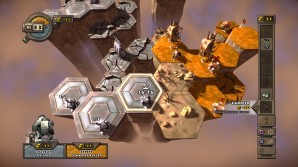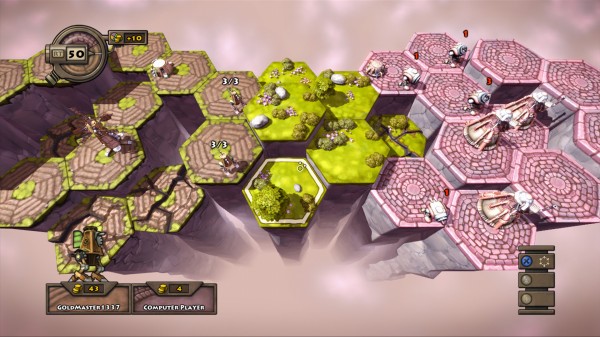Greed Corp XBLA, PSN Review

If Al Gore were to put his face on a video game (regardless of the impact on sales it would probably have) it would almost definitely be thatgamecompany’s Flower. If he were to back a second, however, then there’s a good chance it would be Greed Corp. Building on similar environmental themes as the aforementioned Playstation Network exclusive, Greed Corp is a turn-based strategy game that sees you harvesting the land to fund the war effort against a variety of opposing factions. Based in developer W!’s semi-steampunk Mistbound universe, and using the industrial revolution of the mid 1800s as a focal point, Greed Corp draws on the ways in which the environment has been ruined in our attempt to progress as a race.
It does this by having an ever-deteriorating battlefield as a stage on which to fight. The area is divided up into a honeycomb of hexagonal pieces that begin as natural environments such as forests, swamps and deserts. From the starting point each faction can move into adjacent hexagons, turning them into that faction’s specific colour and allowing them to start building. In order to make money (with which each faction can build troops and cannons) the land must be harvested – which is where the game throws out its first dilemma.
The interlinking hexagons on which the game is played are set on top of column-like structures. As a column is harvested, both it and its immediate surrounding hexagons are lowered by a single layer. Once the area has been harvested to its final layer, it crumbles away into the great unknown, taking anything that resided on top of it along for the ride. As the factions move throughout the battlefield more and more of it wears away, often leaving the survivors to duel it out on a handful of remaining columns.
It makes for some superb tactical thinking, and as players become accustomed to the nature of Greed Corp, the game opens up to reveal a surprising amount of strategic play. For example, with the money gained from harvesting, a faction can build a cannon. Firing at a hexagon with the cannon reduces it by a single layer. If a hexagon is down to its final layer (signified by the surface being strewn with cracks) then the cannon will finish it off, but more importantly any other cracked hexagons linked to it will be taken out in a chain reaction. Similarly, the only way to remove a harvester from the game is to either let it run its course and wait for it to fall away with the rest of the rubble, or get it to self-destruct. While self-destructing means the harvester and the land it stands on will still be lost, it will also set off a similar chain reaction as the canon. On paper it doesn’t sound like much of a difference, but in the heat of battle when a player is down to just a few areas of land, the decision could either secure a victory or result in absolute failure.
It’s a game lathered in tension, made more so by the time limit for each turn. Each faction only gets sixty seconds to plan and execute their turn, requiring a constant observation of the battlefield and how it changes. A lot of the game involves multiple enemies fighting one another at the same time, which adds even more depth to the strategy – do you hit the most powerful and wear him down, or do you hit the weakest and try and take him out early, reducing the number of targets to think about?
Despite its simplistic guise, Greed Corp can be a brilliantly complex game. Though there are only a handful of units to choose from, using them to their full potential is a skill gained through experience. There’s a tutorial at the beginning of the single player campaign that runs you through the basics, but it’s only through observing the nature of the (surprisingly tough) computer opponents that you begin to understand just how much the land can be manipulated in your favour. Air dropping troops onto an enemy hexagon so you can build a harvester in the middle of their controlled area just so you can sacrifice it and take out a huge portion of the map, is the sort of thing you only really learn from initially being the victim.
Taking the skills learned through encounters like these and applying them online is where the fun really begins. The problem being that there doesn’t appear to be a huge amount of people playing. Having a couple of like-minded friends to play against is definitely recommended, although there is an option to create a game against the computer from the main menu should you have awful friends.
Greed Corp has been a welcoming surprise. While it’s not considered to be part of the ‘Xbox House Party’ line-up (probably due to being multiplatform) in many cases it deserves far more attention than those that are. With a lengthy story-mode, on and offline multiplayer and endless replay-value, for 800MSP/£7.99 it’s an absolute steal. Even in this busy period of triple-A releases, you could do a lot worse than find a free moment to check it out.




